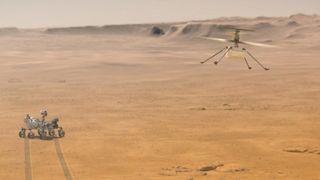Mars Ingenuity becomes first aircraft ever grounded on another planet due to weather
Some rough weather delayed Ingenuity Flight 19 earlier this month

We've all been there, but until this month, we've never had a flight delayed due to inclement weather on another planet.
NASA's Mars Ingenuity helicopter, slated for flight 19 on the red planet, had to delay its anticipated January 5, 2022, take off after an unexpected dust storm swept through the region.
The flight has been rescheduled for January 23.
Obviously, predicting the weather is hard even in the best of circumstances, but trying to predict it on a planet millions of miles away is very near rocket science.
"As weather forecasters, our job is to provide an evaluation of current weather conditions against flight requirements," Jonathan Bapst and Michael Mischna, of the Ingenuity Weather/Environment Team at NASA's Jet Propulsion Laboratory, said in a statement.
"What are these requirements for acceptable and safe flying? Favorable conditions hinge on two key properties: air density and wind speed.
"Although we do not have the advantage of a large number of weather stations or orbiting weather satellites at Mars, as is the case on Earth, we do have a number of tools at our disposal to determine if conditions are acceptable for flight."
Get daily insight, inspiration and deals in your inbox
Get the hottest deals available in your inbox plus news, reviews, opinion, analysis and more from the TechRadar team.
The nearby Mars Perseverance rover, for one, has the Mars Environmental Dynamic Analyzer (MEDA), which can measure the air density, wind speed, and direction throughout the day, which can then give engineers back on Earth the data they need to determine changes in the climate due to seasonal changes on the planet.
Analysis: this is actually a pretty serious situation

While joking about delayed flights is fun and all, we need to remember that solar power is essential for operating drones on Mars, and dust in the atmosphere can be potentially fatal to a mission.
That is exactly what happened to the Mars Opportunity rover, whose record-breaking 14-year mission on Mars came to a sudden end in 2018 when a massive dust storm plunged it into darkness and prevented its solar panels from recharging its batteries.
Mars Ingenuity landed back in February 2021, which was at the start of the Martian Spring. It has operated through the Spring and Summer months on Mars when the air density is more favorable, winds are less intense, and dust storms are far less frequent.
The Martian Autumn, set to begin on February 24, will see a considerably higher frequency of dust storms and high winds. The Martian year is nearly twice as long as a year here on Earth, and so its seasons are also about twice as long as ours.
Ingenuity's original mission was only to demonstrate that flight on Mars would be possible and was only expected to last about a month. After it succeeded beyond expectations, its mission was extended to include an "operational phase."
It wasn't meant to fly or operate during the harsher autumn and winter months on Mars, so the next year will be a real test for Ingenuity. "We will remain diligent in our efforts to safely fly Ingenuity for the foreseeable future," Bapst and Mischna said.

John (He/Him) is the Components Editor here at TechRadar and he is also a programmer, gamer, activist, and Brooklyn College alum currently living in Brooklyn, NY.
Named by the CTA as a CES 2020 Media Trailblazer for his science and technology reporting, John specializes in all areas of computer science, including industry news, hardware reviews, PC gaming, as well as general science writing and the social impact of the tech industry.
You can find him online on Threads @johnloeffler.
Currently playing: Baldur's Gate 3 (just like everyone else).
